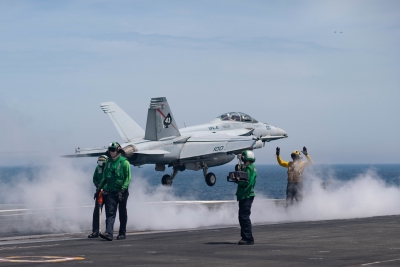
Without steam catapults most modern, heavy aircrafts would be unable to take off from their carriers. Today, every aircraft carrier has them.
In operation, the aircraft taxis into position and a wire loop called a hold back is connected between the rear of the aircraft and a strong point on the deck; it has a weak link in its centre.
A towbar near the aircraft’s front wheel is lowered into a shuttle that attaches the aircraft to the catapult with a hook mechanism. It is the only part of the catapult visible on the flight deck.
Two parallel cylinders at least 150ft (45m) long, run under the deck ahead of the aircraft. The cylinders house two pistons which are both fixed to the shuttle. Steam is supplied to the cylinders from the ship’s boilers via an accumulator where pressure is built up. Pressure is varied for launching aircraft of differing weight.
At launch, the aircraft selects full power, but is restrained by the hold back. When the catapult is fired the combined force of the engines and steam pressure break the weak link and the aircraft hurtles forward, reaching about 135 knots (250km/h) 50yds (45m).
At the end of the launch the aircraft flies out of the shuttle. Probes on the front of the pistons ram into a water reservoir, bringing them to rest in a few feet. The shuttle is then res-positioned for the next launch – carriers can launch an aircaft every 2 minutes per catapult. American carriers have up to four catapults, so a plane can be launched every 30 seconds.
The steam catapult was invented by Commander C.C. Mitchell, of Britain’s Royal Navy, an in 1949 it was installed for trails in HMS Perseus. Steam catapults were installed on carriers worldwide after the US Navy adopted the equipment in 1954.
Picture Credit : Google




